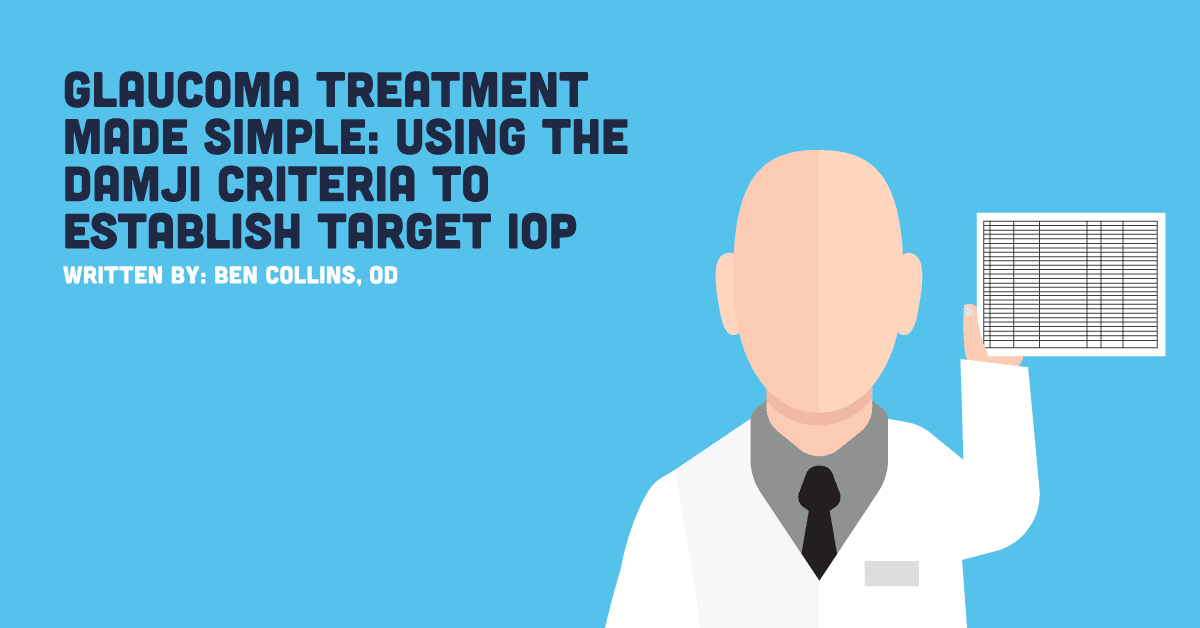A common challenge eye doctors encounter with each glaucoma patient is establishing a “target IOP.” I remember feeling frustrated at the beginning of my career trying to determine the target IOP for each patient since many studies don’t seem to provide very direct guidance on this important topic. A glaucoma specialist helped relieve my frustration by introducing me to the Damji criteria. The Damji criteria not only helps establish a target IOP very simply, but it also helps classify the stage/severity of glaucoma with a simple visual field test. Once a visual field test has been obtained, the practitioner can then have a guideline for how aggressive they need to be in treating the glaucoma.
Utilizing the Damji criteria
The below table provides a simple but effective treatment protocol when treating glaucoma. Remember, these are just initial treatment guidelines and practitioners may need to modify their treatment as time goes on depending on how the patient responds to treatment.
Once the initial treatment guidelines have been achieved according to the above table, the patient will still need to be monitored with regular visual fields and IOP checks. If the visual field continues to progress/worsen despite reaching the initial target IOP, the treatment will need to become more aggressive. Modification of IOP continues to be the only reliable treatment method for glaucoma, so if VF progression is detected then the practitioner will need to “get that IOP lower” (as my previous mentor once said) with the addition of more drops or perhaps surgery. Occasionally, some patients will require an IOP as low as 8-9 in order to achieve stability.
A New Approach to Treating Glaucoma – Blood Pressure Management
Lastly, I just want to mention one last treatment option if the patient is on maximum IOP lowering meds and their VF is still progressing. Simply take the patient’s BLOOD pressure and check for decreased ocular perfusion pressure (OPP) by following the simple formula:
Decreased Ocular Perfusion Pressure: Diastolic BP – IOP = <55 mmHg
If ocular perfusion pressure is less than 55, then the patient has decreased blood flow to the optic nerve and you will want to try and raise that patient’s blood pressure in addition to lowering the IOP.
(There are other more complicated formulas that can be used to calculate OPP, but I find this formula provides a good rough estimate for the practitioner. Altering BP to treat glaucoma is a fairly new treatment option for eye doctors and needs to be studied more in order to have a better understanding of its effect on glaucoma progression.)
(There are other more complicated formulas that can be used to calculate OPP, but I find this formula provides a good rough estimate for the practitioner. Altering BP to treat glaucoma is a fairly new treatment option for eye doctors and needs to be studied more in order to have a better understanding of its effect on glaucoma progression.)
Possible ways to raise blood pressure are to reduce the dose of the BP meds that the patient is taking, discontinue one BP med, or simply have the patient change the time of day that they take the BP meds. Regarding time of day, since most patient’s IOP is the highest at night while the patient is sleeping, we don’t want the patient to take their BP meds right before bed. Such timing would lead to a relatively high IOP concurrent with a very low BP, which would adversely affect OPP and the amount of blood getting to the optic nerve. If the patient can simply switch the timing of taking their BP meds to the morning rather than bedtime, then the patient will have a much more favorable condition for better blood flow to the optic nerve.
Of course, you will want to work with the patient’s primary care doctor before stopping blood pressure medicines or switching the timing those BP meds. A simple letter to the PCP explaining the situation is usually all that is required to get things moving in the right direction.
In conclusion, following the Damji criteria provides a simple and effective protocol to treating glaucoma patients at any stage of severity. By utilizing this criteria, you can be confident that you are treating according to the basic standard of care. Regular visual field tests and IOP checks will need to be performed throughout the year to ensure that the visual field is not worsening. If you note visual field worsening despite reaching target IOP, you will need to be more aggressive at lowering the IOP either through additional eye drops or surgery.
